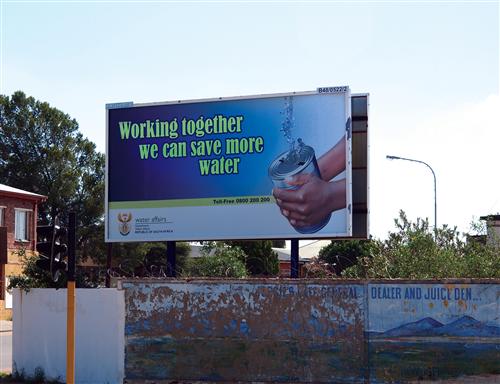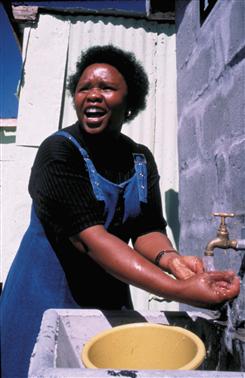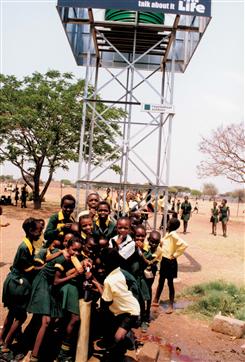Water Conservation
Water conservation is the minimisation of water loss, the care and protection of water resources, and the efficient and effective use of water. The concept generally focuses on the efficiency of processes or actions associated with water resources.
In order for water conservation strategies to be effective, significant awareness raising is required in the form of campaigns through workshops, discussion forums, and newsletters to integrate the principles of water conservation into people's daily lives.
All of the countries in the basin have limited water supplies, and anticipate increasing demand for water as a result of climate variability and change, population growth, and industrial development. It is, therefore, very important that all water use sectors optimise the use of water to ensure that both basic human needs and the needs of the environment are met, now and in future. Implementation of water conservationprinciples is essential.
The goals of water conservation include:
-
Sustainability - To ensure availability for future generations, through the sustainable use of water
-
Energy conservation - Water pumping, delivery, and wastewater treatment facilities use significant amounts of energy
-
Habitat conservation - Minimising water use helps to preserve fresh water ecosystems, as well as reducing the need to build dams and other water diversion infrastructure
The SADC Protocol on Shared Watercourses requires all basin states to adopt Integrated Water Resource Management Plans (IWRMP) to address water resource usage and conservation. This is further discussed in the Governance theme.
Box: Emfuleni – meeting the challenge of water awareness and water conservation
Sebokeng and neighbouring Evaton are townships within the largest local municipality in South Africa, Emfuleni. The roads here are paved and bordered by rows of neat brick houses with tidy lawns and fences. There are small shops, taverns and industrial premises, and also a modern shopping centre. Obviously, most people, who live here, are not poor. Nevertheless, every household receives a free allowance of six kilolitres (m3) of water per month. If a household uses more than that, it is supposed to pay 11 Rand per kilolitre.
In reality, only 10 to 15 percent of all households pay for their water. Worse still, most of the water being supplied is not even used. One reason: The pipe network of the local water provider Metsi-a-Lekoa is in dire need of repair. The main reason: Most taps, showers and toilets in Sebokeng and Evaton are not functioning properly and water drips and runs day in and day out. Very few people repair anything. “They don’t care how much water they waste. After all, most are not paying for it”, says a local citizen. Households in Sebokeng and Evaton in fact consume an average 20 kilolitres of water per month. Of that, less than half is actually used. And in some houses up to 200 kilolitres pours down the drain, unused.
Metsi-a-Lekoa has to foot the bill, buying supplies from Rand Water which is one of South Africa’s biggest suppliers. Instead of paying 100 to 150 million Rand for the water actually used, it ends up paying double that. Because of this there is hardly any money left over for investment in new pipe infrastructure and/or maintenance of the existing system.
Another problem is that the wasted water disrupts Emfuleni’s waste water treatment plant. Sewage treatment depends on bacteria feeding on organics during the night. But at Emfuleni that doesn’t happen because unscheduled flows of clean water flush the bacteria away. When a fresh organic load arrives in the morning, the bacteria are all gone.
In 2005, Metsi-a-Lekoa” started to act on the challenge. Together with the water-engineering consultancy WRP (and in cooperation with the communities), they installed a pressure management system which regulates pressure in the main supply pipes to Sebokeng and Evaton. This system allowed the municipality to reduce its water losses:
Computer-controlled valves regulate water pressure for 80 000 households comprising 450 000 people. At peak hours, mornings and evenings between six and eight, water is supplied at full pressure of 3 500 kilolitres per hour. Outside these times the valves only allow 2 500 kilolitres per hour. This system of pressure reduction during times of low demand reduces the leakage rate without limiting the supply to users. Most people wouldn’t even notice the difference.
The business model for the installation of the pressure management system was unconventional, with WRP providing the initial 10 million Rand capital for the installation at its own risk. In return, over the first five years the company was given 15% of the savings achieved by the water supplier thanks to using the pressure management system.
The result was a great deal for both parties. Consumption in Sebokeng and Evaton dropped by ten percent; WRP earned a good return; and between 2005 and 2010, Metsi-a-Lekoa saved a staggering 150 million Rand and continues to save. The water provider now has some available budget to upgrade its old pipe networks.
In spite of this, the key reason for water wastage in Sebokeng and Evaton remained in place – people’s wastage of water. At this stage the German government’s development agency GIZ got involved in Emfuleni. GIZ is implementing the Transboundary Water Management in SADC Programme in collaboration with the UK Department for International Development (DFID) and the Australian Agency for International Development (AusAID).
GIZ and the petrochemical group Sasol, whose Sasolburg plant is roughly 12 kilometres south of Sebokeng, have formed a developmental partnership to tackle the root causes of water wastage. This large-scale water campaign will be strengthened by the partners’ diverse and symbiotic expertise and ten million Rand in seed funding provided by GIZ and Sasol.
“Our first task will be to train plumbers and semi-skilled local people in the townships,” explains Thembi Mkhize, Metsi-a-Lekoa’s chief director. “They will then go from house to house to check and fix taps, toilet cisterns, showers and water meters. They will also be tasked to educate the community about water loss minimization and fixing leaks. In parallel, our Customer Care Department will work with schools to create awareness amongst children about our country’s water scarcity and how to use this precious resource sparingly. These initiatives are, of course, being launched with support of key local residents and political committees.”
“Just by saving water, this partnership will earn back the initial funding many times over,” informs Horst Vogel, head of GIZ’s Transboundary Water Management in SADC programme. In its first three years the partnership should save approximately 60 million Rands, and it is expected this will later increase to an annual three-digit million number. The funds will flow back into the project to allow the ailing water infrastructure to be overhauled. At least for the first three years, from July 2011 to June 2014, the arrangement is governed by contracts and is being monitored by independent auditors.
Thembi Mkhize believes that this public-private partnership will noticeably improve the quality of life for the citizens of Sebokeng and Evaton. “New jobs will be created. The water supply will become ever more reliable. And the people’s sense of community and responsibility will be strengthened.”

Public awareness materials for a South Africa Water Conservation Campaign.
Source:Vogel 2011
( click to enlarge )
Water Re-Use
Re-using water is also a form of conservation, as the re-used water replaces water that would come from other sources. Virtually all the water coming out of a tap can be used at least twice. The discharge water from one process, say bathing, could be fit for further use, such as garden irrigation.
Water re-use not only provides an alternative source of water, it reduces pollution by minimising the discharge of wastewater. Additionally, water re-use in the largest sectors—agricultural and industrial—allows for a greater allocation to other sectors. Properly implemented, water re-use has the potential to bring about significant environmental, economic and financial benefits.
The concept of water re-use is applicable at both the household scale and at the large industrial and mining scale. At the household scale, grey water (un-treated householdwastewater discharged from bathtubs, showers, wash basins and washing machines) can be re-used without pre-treatment for agricultural or landscape irrigation, with due care because certain plants are sensitive to detergents and other cleaning materials.
Effluent from wastewater treatment plants can also be re-used, for purposes ranging from irrigation to urban applications. Effluent re-use for agriculture should be practiced with good management to prevent adverse human health impacts. Water for many purposes does not have to be of the same quality as drinking water: treated domesticwastewater, though non-potable, may be suitable for toilet flushing in business orcommercial buildings, car washing, garden irrigation, etc.
As the irrigated agriculture sector is the largest user of water within the Limpopo Riverbasin, water conservation strategies should focus on this user group to obtain maximum savings. Significant savings can be obtained by reducing conveyance lossesin canals, scheduling irrigation appropriately, metering and pricing irrigation water, and improving efficiencies in irrigation systems.
Botswana
In southern Africa, Botswana and South Africa have developed partial water accounts, and there is a drive to incorporate wastewater into these accounts as a method of water re-use and conservation (Arntzen and Setlhogile 2007). In Botswana, re-using wastewater and defining it as an economic resource was emphasised in the 2003 National Master Plan for Wastewater and Sanitation. In the plan, wastewater can either be released to the environment or re-treated in wastewater treatment works. Re-treated wastewater could partially replace new withdrawals of fresh surface and dgroundwater flows.
Water recycling is currently being investigated as part of Botswana's strategy to address increasing demand for water. This subject is discussed in more detail in a SADC Waterwire article from August 2010.
Lesotho
The Lesotho Department of Rural Water Supplies found that 30% of rural water points (boreholes, springs and wells) have dried up and thousands of people are dependent on limited surface water supplies. Climate change may only exacerbate the situation (UN 2008). To address these issues, the Millennium Challenge Corporation and the Kingdom of Lesotho have signed a multi-million dollar Compact to reduce poverty and increase economic growth (MCC 2009). Water will be provided to rural households as part of the national watershed management and wetlands conservation plan under the Compact.
Namibia
Erratic rainfall, high riverbed losses through evaporation, scarce vegetation, limited topsoil and impermeable surfaces all contribute to Namibia’s ephemeral rivers and low groundwater recharge rate. In a country where 83% of the rainfall evaporates, 14% is used by vegetation, 2% contributes to runoff and 1% contributes to groundwater recharge it is of vital importance to implement stringent water conservation measures (Bethune et al.). The Water Resources Management Act, adopted in December 2004, charges a Water Resources Management Agency with the conservation and management of water resources in Namibia.
South Africa
The National Water Act (1998) of South Africa includes fundamental reforms with respect to the sustainability of water use in the mostly semi-arid country. To satisfy this reform, all agricultural water user associations must submit a Water Management Plan detailing their current infrastructure management practices, measure the use and management of irrigation water, develop a water balance (inputs and outputs), and identify best management practices for water conservation and demand management (DWAF 2009a).
 Conserving water today..... Source:DWAF South Africa 2001 ( click to enlarge ) |
 ....for future generations. Source:DWAF South Africa 2001 ( click to enlarge ) |
Water Conservation Tips
-
Fix leaking pipes or dripping taps, shower heads and toilets.
-
When rinsing vegetables fill a bowl or the sink with some water instead of letting the tap run.
-
Take shorter showers.
-
Fill up a bottle and put it in the fridge for drinking instead of running the tap until cold water comes out.
-
Water lawns early in the morning or in the evening to allow the water to percolate into the soil and not evaporate immediately due to solar energy.
-
Allow lawns to grown longer in dry weather so that the grass retains the moisture and does not require such frequent watering (also good for insects!).
-
Use a drip irrigation system instead of a sprinkler.
-
Cover swimming pools when not in use.
-
Use swimming pool water from the back-washing or draining operations to water lawns and plants
-
Collect rainwater to water plants.
